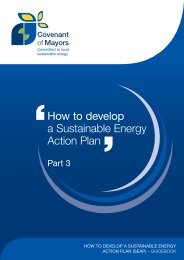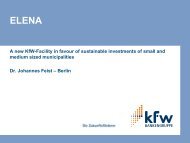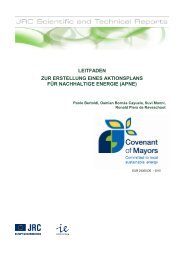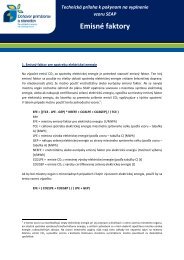English - Covenant of Mayors
English - Covenant of Mayors
English - Covenant of Mayors
You also want an ePaper? Increase the reach of your titles
YUMPU automatically turns print PDFs into web optimized ePapers that Google loves.
Vehicle fleet distribution<br />
The vehicle fleet distribution indicates the share <strong>of</strong> each<br />
vehicle type <strong>of</strong> the mileage. At minimum, the fleet distribution<br />
should distinguish between:<br />
• passenger cars and taxis;<br />
• heavy and light-duty vehicles;<br />
• buses and other vehicles used for public transport<br />
services;<br />
• two-wheelers.<br />
The fleet distribution can be estimated based on one <strong>of</strong><br />
the following sources:<br />
• traffic counts as discussed above;<br />
• vehicles registered in the municipality;<br />
• national statistics;<br />
• Eurostat statistics at national or regional level.<br />
Use <strong>of</strong> any <strong>of</strong> the data sources above should be accompanied<br />
with a consideration on whether it represents an<br />
appropriate estimate <strong>of</strong> the distribution <strong>of</strong> mileage driven<br />
in the territory <strong>of</strong> the local authority. The data can be<br />
adjusted to better suit to the local authority’s territory if<br />
needed. For instance, the share <strong>of</strong> mileage driven in a city<br />
by heavy-duty vehicles may be lower than the share <strong>of</strong><br />
heavy duty vehicles registered at national level.<br />
Some <strong>of</strong> the existing tools for local emission inventories<br />
may include default fleet distributions for different regions.<br />
These can be used if they are considered appropriate by<br />
the local authority.<br />
Average fuel consumption per km<br />
Average fuel consumption <strong>of</strong> each vehicle category<br />
depends on the types <strong>of</strong> vehicles in the category, their age<br />
and also on a number <strong>of</strong> other factors, such as the driving<br />
cycle. The local authority is recommended to estimate<br />
average fuel consumption <strong>of</strong> vehicles driving on the street<br />
network based on polls, information from inspection agencies<br />
or information on vehicles registered in the municipality<br />
or in the region. Auto clubs and national transport<br />
associations are also sources <strong>of</strong> useful information.<br />
Especially if the local authority is planning measures to<br />
reduce the average fuel consumption <strong>of</strong> vehicles, for<br />
instance by promoting the use <strong>of</strong> electric or hybrid vehicles,<br />
it is recommended not to use national or European average<br />
fuel consumption figures, but to make a more detailed<br />
estimate (as explained above) including hybrid and electric<br />
cars separately. This is because if averages are used, the<br />
reduction in fuel consumption due to measures will not be<br />
visible when comparing the BEI and MEI.<br />
Calculation <strong>of</strong> activity data<br />
The activity data for each fuel and vehicle type will be<br />
calculated by the following equation:<br />
Fuel used in road transportation [kWh] =<br />
mileage [km] x average consumption [l/km]<br />
x conversion factor [kWh/l]<br />
The most typical conversion factors are presented in<br />
Table 7. A full list <strong>of</strong> conversion factors (net calorific values)<br />
is presented in Annex I. An example <strong>of</strong> the use <strong>of</strong> the<br />
Equation is given in Box 6.<br />
TABLE 7. CONVERSION FACTORS FOR<br />
THE MOST TYPICAL TRANSPORTATION<br />
FUELS (EMEP/EEA 2009; IPCC, 2006)<br />
FUEL<br />
CONVERSION FACTOR (KWH/L)<br />
Gasoline 9.2<br />
Diesel 10.0<br />
23<br />
Use <strong>of</strong> national level average fuel consumption for each<br />
vehicle category may produce biased estimates, in<br />
particular for urban areas. This might occur especially in<br />
countries with a dense motorway network linking cities<br />
and where a high number <strong>of</strong> rural trips are made, as the<br />
figures for fuel consumption would not be representative<br />
for urban areas.












